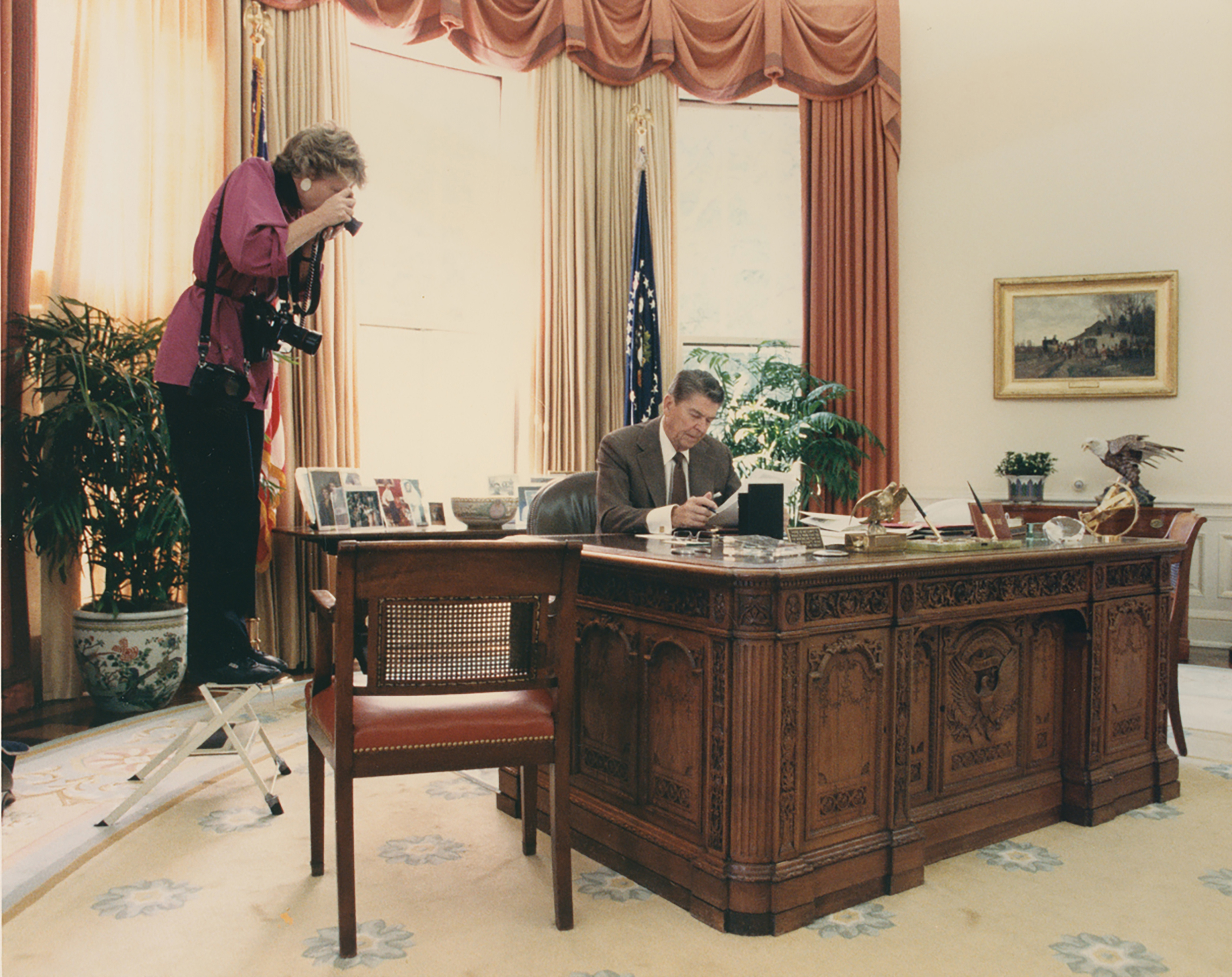
From Richard Nixon to Barack Obama, renowned White House photographers reveal their most cherished moments with U.S. presidents
Alexandra Genova | Michelle Molloy
As President-Elect Donald Trump prepares to take the country’s reigns, TIME asked 12 White House photographers to reflect on the essential characteristics of the men who came before him.
Some leaders fall easily into categorization; the diplomat, the freedom fighter; the family man. Diana Walker’s photograph of a laughing Ronald Reagan sharing a joke with his cabinet shows he was undoubtedly a charmer. In Robert McNeely’s picture of Bill Clinton he appears as the charismatic negotiator, calmly convincing Newt Gingrich to his ideas. While other presidents’ legacies transcend individual traits and come to symbolize a shift in history, as shown in Pete Souza’s image of a young boy touching Barack Obama’s hair – a photograph that quietly reveals both the man and the moment.
These photographs and their stories unlock a well-guarded door and, in doing so, invite the viewer to consider what makes a man a president.
GEORGE W. BUSH (2001 – 2009)

Christopher Morris, a TIME photographer: “Back in December 2004, in an extremely rare opportunity offered to TIME, the White House authorized me to travel with the President to Bethesda Naval Hospital, where the president was going for his annual medical exam. He would be traveling on Marine One, that takes off and lands from the south lawn of the White House. To be able to travel with him on Marine One was an extremely rare opportunity.
“After his medical exam, the president proceeded to the recovery wards where he spent the rest of the day visiting wounded military personal from the Iraq war and some of their families. For this, I was personally allowed to accompany the president and a small group of aides. After probably half a dozen rooms, I backed off and waited outside in the hallway because of emotional concerns for the families and myself. I say myself for I challenge anyone to witness that and not have their insides emotionally torn. These moments were extremely heavy and private. Witnessing this in a very small room, brought home the true meaning of being the president of the United States. In each instance the president’s Military Aide would read out the Purple Heart citation, with the president then pinning it on the serviceman’s gown. Many had suffered extreme cranial damage.
“At the end of the day I waited next the motorcade as, I did not know if they were going to let me return on Marine One or just be reinserted into the protective travel press pool. Upon seeing me standing near the Presidential limousine, the president signaled for me to get in the car. Once inside the protected small space of the limo, I could physically sense his emotions as a result of what he had just encountered.
“Rarely would I ever directly engage the president as this is not my role. But, sitting knee to knee with him in the vehicle, I said: ‘That was an extremely heavy thing for you to do.’ As we drove away, he said: ‘I do it because I sent them there.’ Once on board the helicopter as we took off, his eyes watered, staring out the window, his lip quivered, then he spoke: ‘Please no more pictures.’ This is the last frame from the series I took that day.”
BARACK OBAMA (2009 – 2016)

Callie Shell, a TIME photographer: “I picked the February 2009 dancing photograph, taken at the Governor’s Ball at the White House, because I hope it shows the love that President Barack Obama has for his wife. I think a strong president has a strong person beside them. I believe that the First Lady is his rock and keeps him grounded. She helps him laugh at himself and the world around him to lighten the stress.”
GEORGE H.W. BUSH (1989 – 1993)
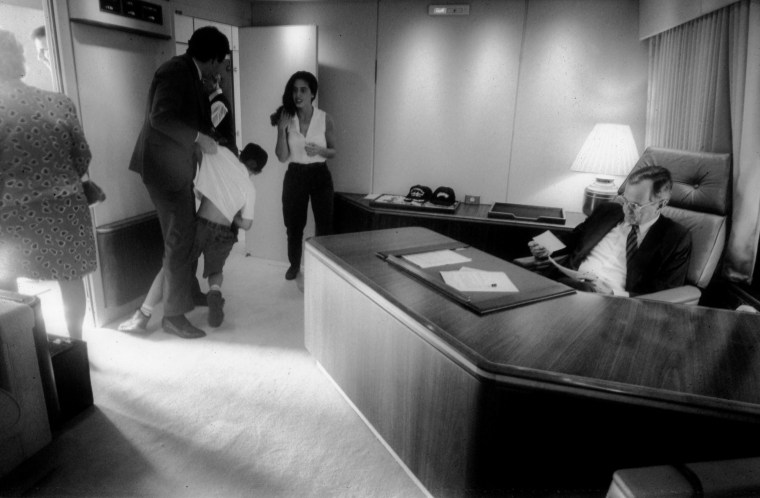
Diana Walker, one of TIME’s White House photographers: “During the Republican convention of 1992, I had been granted behind-the-scenes access with President George H.W. Bush for its duration. This meant I would be allowed to shoot briefly some things on the president’s schedule that were not open to the press, for a picture story to run most likely the following week in TIME. Having been slipped quietly into the president’s office on Air Force One, just as the plane’s door had been opened as the Bush family arrived in Houston, imagine my surprise to catch the first lady walking out, far left; Marvin lassoing the exuberant grandchildren tearing in and out of the plane’s office, while the president was deep in thought looking over his preparation notes for the day.
This exemplified why TIME wanted me behind the scenes, to catch unscripted moments to show the humanity of our presidents, away from the lights and mics.”
WILLIAM J. CLINTON (1993 – 2001)
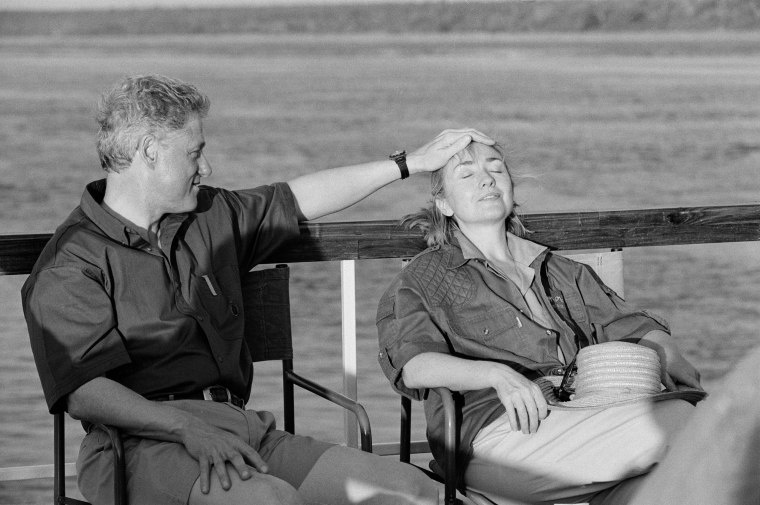
Diana Walker, one of TIME’s White House photographers: “In March of 1998, a few months before the public admission by President Clinton that he had indeed had an improper relationship with a White House intern, I was given much access to the President and Mrs. Clinton on their long-anticipated trip to several countries in Africa. At the end of the day in Botswana, I was on the president’s boat having a conversation across the deck with Mrs. Clinton’s press secretary, having decided to move away from the Clintons to give them a break from my presence.
“The boat that was carrying the press had returned to port at Kasane after their long-distance photo-op of the Clintons cruising along the Chobe river after a day on safari. Staying a bit off to the side on the deck, I had my camera with a 70-200mm lens on my shoulder just in case. Suddenly Mr. Clinton brushed the hair from Mrs. Clinton’s brow; then taking her hand, he held it to his cheek. I raised my camera and had an intimate series of affectionate photographs. There I had what to me was a most human event, whose veracity, then, was questioned. But my eyes saw the essence of a long-enduring relationship: an amazing private moment, displaying essential character.”
GEORGE H.W. BUSH (1989 – 1993)

David Valdez, the then-official White House photographer: “This photo was originally taken for Bobbi Baker Burrows of LIFE magazine in August 1987. She had asked for a photographer to go to Kennebunkport to photograph the Bush family on vacation. George Bush said no. Bobbi pushed back.
I talked to Barbara Bush about Bobbi’s request and Barbara suggested to come over to their house at Walkers Point the following morning to see what happens. I arrived around 6 A.M. and chatted with the Bushes for a few minutes before the grandchildren started coming in. I took this photo and Bobbie ran it double truck in LIFE.
President Bush, after everything he had accomplished in his life, said the most important thing to him was his family, his faith and his friends. He was always so proud of all of his children but certainly was busting with pride when he attended the swearing in as president of one of his sons, George W. Bush.”
GERALD FORD (1974 – 1977)

David Hume Kennerly, who was appointed personal photographer to President Ford: “I met Silas ‘Sikes’ McGee when he visited President Gerald R. Ford at the White House in 1974. Sikes was the only African American member of the Grand Rapids South High School football team in 1930, and young Jerry Ford was his teammate. Sikes told me there were three things about the future president that went directly to the character of the man I came to know as his White House photographer: When it came to race Ford was color blind. When it came to injustice he stood up for those who were being persecuted. And when it came to integrity, nobody was more honest.
As this picture shows, President Ford also had a wonderful and warm sense of humor. His old teammate made him laugh, they were after all, as Sikes put it, ‘brothers’.”
BARACK OBAMA (2009 -2016)

Pete Souza, the president’s official White House photographer: “A temporary National Security staff member, Carlton Philadelphia, brought his family to the Oval Office for a farewell photo with President Obama on May 8, 2009. Carlton’s son Jacob softly told the President he had just gotten a haircut like President Obama, and asked if he could feel the President’s head to see if it felt the same as his. In many ways, this photograph became a symbol on what it meant to others for him to be the first African-American president. But it also showed–even though he was the President of the United States and the ‘most powerful man in the world’–that it was okay to just be a regular guy.”
GEORGE W. BUSH (2001 – 2009)
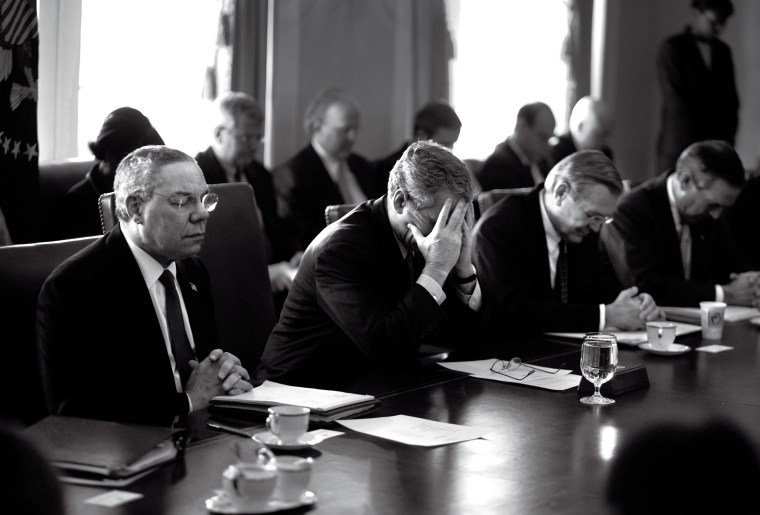
Brooks Kraft, who covered the White House for TIME during the Bush presidency: “On the morning of the State of the Union Address, weeks before the 2003 Iraq invasion, as with every cabinet meeting, Bush opened the discussions with a prayer. For me, the photo captures the mood in the room and the weight of the impending monumental decision on a presidency – and history. The contrast between the President’s body language and that of Powell and Rumsfeld is visible and I like how those in the room appear still… in waiting.”
RICHARD NIXON (1969 -1974)

Harry Benson, who was on assignment for LIFE: “Of the 11 U.S. presidents I have photographed, Nixon has always intrigued me. He was a man who never veered from his goal in life of becoming president. He never turned down my request for a photograph and once told me, ‘You should always let a professional person do his job’.
Shown here in 1974 during a speech at the Knesset, as the troubles of Watergate were escalating. Israel was one place where Nixon was revered, and Golda Meir introduced him as the ‘best president Israel ever had’. As Nixon spoke, the massive Chagall mural of Moses with the Ten Commandments loomed behind him. What struck me was the way Nixon’s hands serendipitously duplicated the hands in the mural.”
RONALD REAGAN (1981 – 1989)

Pete Souza, a then-official White House photographer: “This photograph of President Reagan in 1988 was made with a remote camera mounted on the molding that held the overhead fluorescent lights. I made a series of images throughout the day, but I always thought the best frame was when he was working alone at the Resolute desk. President Reagan was very formal when he was in the Oval Office; he never took his suit jacket off unless it was the weekend.”
WILLIAM J. CLINTON (1993 – 2001)

Robert McNeely, the then-official White House photographer: “In looking through images I came to this one from a meeting in the Cabinet Room at the White House in November 1995 to end the government shutdown over the budget. What struck me was the fact that even during a very contentious partisan divide, the President and the Speaker of the House were working together to try to come to an understanding that would end the crisis.
“This was Clinton at his political best because of his understanding of the budget and his ability to convince Gingrich of the path forward. Every time Clinton would get Gingrich convinced though, the Speaker would take the deal back to his members on the Hill, and the members, not having been put under Clinton’s spell, would say no. This went on for a week in November and three weeks December into January. The image, with Clinton the patient teacher explaining to the eager student, sums up the relationship and personalities.”
JIMMY CARTER (1977 – 1981)

Arthur Grace, who covered the Carter administration for TIME: “This photograph of First Lady Rosalynn Carter, Egyptian president Anwar Sadat and Jimmy Carter in 1979, represents President Carter’s deep commitment to peace in the Middle East. It was a priority for him along with his unwavering stance on human rights. Whatever else happened negatively for him during his time as President, he will always be remembered for forging a peace treaty between Israel and Egypt which is still in place today and for his principled stand on human rights around the world.”
GEORGE W. BUSH (2001 – 2009)
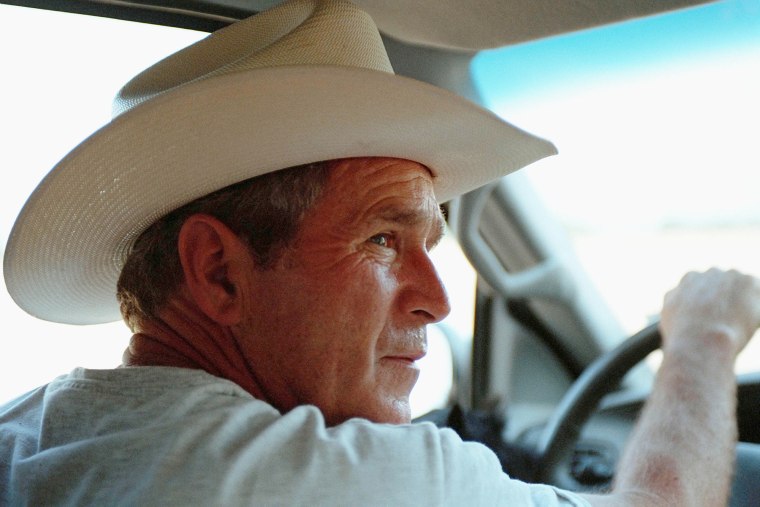
Eric Draper, the then-official White House photographer: “Out of the millions of photos that I have taken of President George W. Bush, this image, taken in August, 2001, stands out because it captures his personality in an iconic way. The 43rd president is a proud Texan and he loves wearing his cowboy hat on his 1600-acre ranch in Crawford, Texas. It was the only place where he could drive his own pickup truck. This image also captures a twinkle in his eye with a hint of mischievous charm. He never took himself too seriously but considered the job and the institution of the presidency paramount.”
RONALD REAGAN (1981 – 1989)
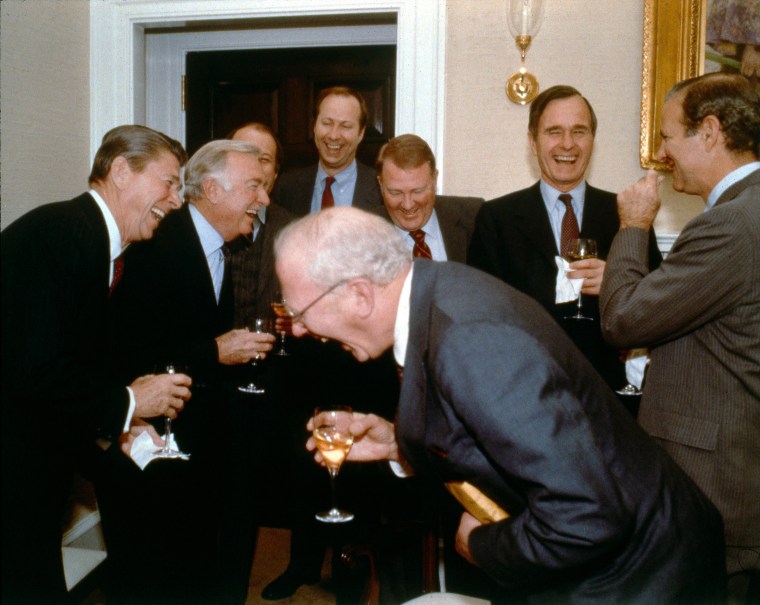
Diana Walker, one of TIME’s White House photographers: “I was so lucky to see this wonderful event! Asked by CBS to photograph the last interview of Walter Cronkite with a sitting president as anchor of the CBS Evening News in 1981. I had finished up, dispatched the film to a waiting courier, and was closing up my bag, when Bud Benjamin, a vice president of CBS came back into the Oval Office and urged me quickly into the adjoining room where the president, only the months into his first term, was hosting a little champagne ‘pour’ for Walter Cronkite.
“There was this happy group of the president’s men, James Brady, Dave Gergen, Edwin Meese, Vice President George Bush, James Baker and CBS’s Bud Benjamin having a high old time, with the legendary Cronkite and the new President, Ronald Reagan telling jokes. This to me shows what an engaging story teller President Reagan was, a man of considerable charm. To me the whole event was an amazing behind the scenes occurrence, where with the exception of the presidential photographer Jack Kightlinger, I was the only camera in the room. This would never have been an ‘open photo’ and I was incredibly lucky to have been there. I vowed to myself always to keep one roll of film in my camera as I luckily had then, just in case!”
WILLIAM J. CLINTON (1993 – 2001)

PF Bentley, a photographer on assignment for Newsweek: “I had known President Clinton from when he was Governor Clinton in 1992 and I had covered his campaign behind the scenes for TIME. I was there at the beginning of his quest for the presidency and wanted to be there at the end. He was unwaveringly loyal to his trusted friends and made you feel like you were the only person in the world when he spoke to you. In this moment, in January 2001, he looked out for what seemed to be a long time, then departed. I stayed to photograph the envelope he had left for President-Elect George W. Bush on the desk in the empty Oval Office. I then ran to catch up to him greeting the President-Elect and Mrs. Bush at their arrival at the North Portico to begin the Inauguration Day sequence of events.”
Follow TIME LightBox on Facebook, Twitter and Instagram.
Lead photograph of Diana Walker on a ladder in the Oval Office photographing President Reagan, was taken by Bill Fitz-Patrick for The White House, on September 20th, 1985
Originally published on Jan. 10
